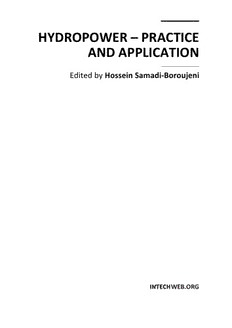
Hydropower - Practice and Application PDF
Preview Hydropower - Practice and Application
HYDROPOWER – PRACTICE AND APPLICATION Edited by Hossein Samadi-Boroujeni Hydropower – Practice and Application Edited by Hossein Samadi-Boroujeni Published by InTech Janeza Trdine 9, 51000 Rijeka, Croatia Copyright © 2012 InTech All chapters are Open Access distributed under the Creative Commons Attribution 3.0 license, which allows users to download, copy and build upon published articles even for commercial purposes, as long as the author and publisher are properly credited, which ensures maximum dissemination and a wider impact of our publications. After this work has been published by InTech, authors have the right to republish it, in whole or part, in any publication of which they are the author, and to make other personal use of the work. Any republication, referencing or personal use of the work must explicitly identify the original source. As for readers, this license allows users to download, copy and build upon published chapters even for commercial purposes, as long as the author and publisher are properly credited, which ensures maximum dissemination and a wider impact of our publications. Notice Statements and opinions expressed in the chapters are these of the individual contributors and not necessarily those of the editors or publisher. No responsibility is accepted for the accuracy of information contained in the published chapters. The publisher assumes no responsibility for any damage or injury to persons or property arising out of the use of any materials, instructions, methods or ideas contained in the book. Publishing Process Manager Ivana Zec Technical Editor Teodora Smiljanic Cover Designer InTech Design Team First published March, 2012 Printed in Croatia A free online edition of this book is available at www.intechopen.com Additional hard copies can be obtained from [email protected] Hydropower – Practice and Application, Edited by Hossein Samadi-Boroujeni p. cm. ISBN 978-953-51-0164-2 Contents Preface IX Chapter 1 Sustainable Hydropower – Issues and Approaches 1 Helen Locher and Andrew Scanlon Chapter 2 Hydropower – The Sustainability Dilemma 23 Wilson Cabral de Sousa Junior and Célio Bermann Chapter 3 Hydrological Statistics for Regulating Hydropower 41 Anders Wörman Chapter 4 Assessment of Impact of Hydropower Dams Reservoir Outflow on the Downstream River Flood Regime – Nigeria’s Experience 61 David O. Olukanni and Adebayo W. Salami Chapter 5 Discharge Measurement Techniques in Hydropower Systems with Emphasis on the Pressure-Time Method 83 Adam Adamkowski Chapter 6 Sediment Management in Hydropower Dam (Case Study – Dez Dam Project) 115 H. Samadi Boroujeni Chapter 7 Application of Microseismic Monitoring Technique in Hydroelectric Projects 143 Nuwen Xu, Chun’an Tang, Hong Li and Zhengzhao Liang Chapter 8 Limnology of Two Contrasting Hydroelectric Reservoirs (Storage and Run-of-River) in Southeast Brazil 167 Marcos Gomes Nogueira, Gilmar Perbiche-Neves and Danilo A.O. Naliato Chapter 9 Reservoir Operation Applied to Hydropower Systems 185 João Luiz Boccia Brandão VI Contents Chapter 10 Hydropower Scheduling in Large Scale Power Systems 201 Monica Zambelli, Ivette Luna Huamani, Secundino Soares, Makoto Kadowaki and Takaaki Ohishi Chapter 11 Fuzzy Scheduling Applied on Hydroelectric Power Generation 227 Carlos Gracios-Marin, Gerardo Mino-Aguilar, German A. Munoz-Hernandez, José Fermi Guerrero-Castellanos, Alejandro Diaz-Sanchez, Esteban Molina Flores and Eduardo Lebano-Perez Chapter 12 Integration of Small Hydro Turbines into Existing Water Infrastructures 239 Aline Choulot, Vincent Denis, and Petras Punys Chapter 13 Project Design Management for a Large Hydropower Station 277 Xuanhua Xu, Yanju Zhou and Xiaohong Chen Chapter 14 Damming China’s and India’s Periphery: An Overview over the Region’s Rapid Hydropower Development 293 Thomas Hennig Preface Hydroelectric power or hydroelectricity is called a renewable energy source because the water on Earth is continuously replenished by precipitation. As long as the water cycle continues, we won’t run out of this energy source. Hydroelectric energy is the most widely used form of renewable energy, accounting for 16 percent of global electricity consumption, and 3,427 terawatt-hours of electricity production in 2010, which continues the rapid rate of increase experienced between 2003 and 2009. In the recent years, measures against global warming have become an important issue for the world. The use of fossil fuels like oil has raised concerns about carbon dioxide emissions, which cause global warming, and the future depletion of energy sources. Against this background, hydropower generation is drawing renewed attention, with renewable energy sources such as solar power and windpower. Hydro is also a flexible source of electricity since plants can be ramped up and down very quickly to adapt to changing energy demands. However, damming interrupts the flow of rivers and can harm local ecosystems, and building large dams and reservoirs often involves displacing people and wildlife and requires significant amounts of carbon-intensive cement. This book is primarily based on theoretical and applied results obtained by the authors during a long time of practice devoted to problems in the design and operation of a significant number of hydroelectric power plants in different countries. That is why the authors have endeavored to offer a large variety of carefully chosen case studies covering a wide range of engineering issues on the field of hydropower plants. Therefore, the subjects being mentioned comprise all the main components of a hydro power plant, from the upstream end, with the basin for water intake, to the downstream end of the water flow outlet. The book is addressed equally to engineers and practitioners in the design, construction and operation of hydropower projects, as well as to research workers and students at universities. The book comprises 14 chapters - chapters 1 and 2 focus on sustainability of hydropower, chapters 3 to 8 cover basic issues of studying hydropower such as hydrological, hydraulic and geological aspects, chapters 9 to 11 deal with operation X Preface and planning, chapter 12 concentrates on the integration of small hydro turbines into existing water infrastructure, chapter 13 covers manufacture management system, and chapter 14 presents the challenges of rapid hydropower development in China and India as a case study. Hossein Samadi-Boroujeni Shahrekord University, Iran
